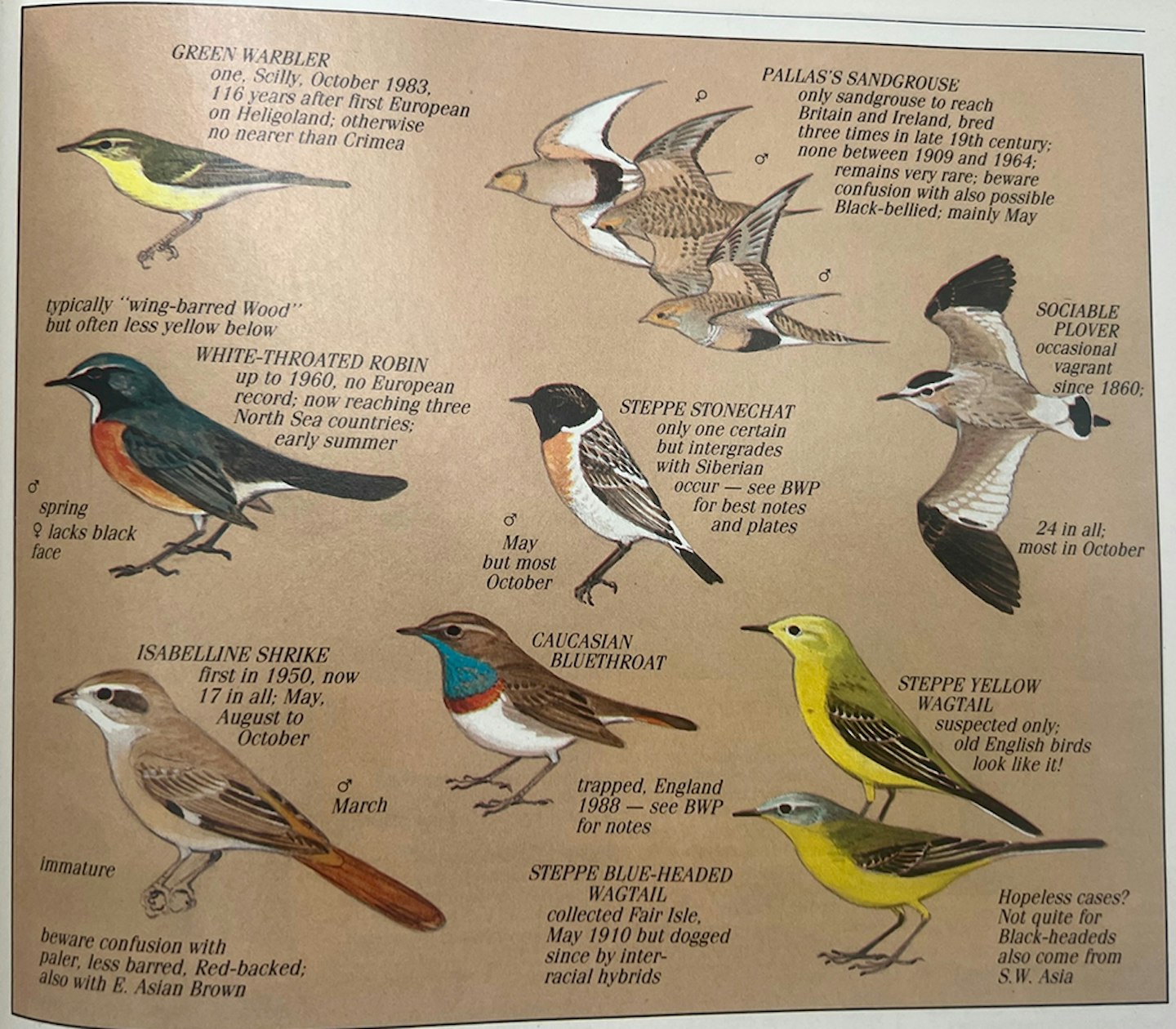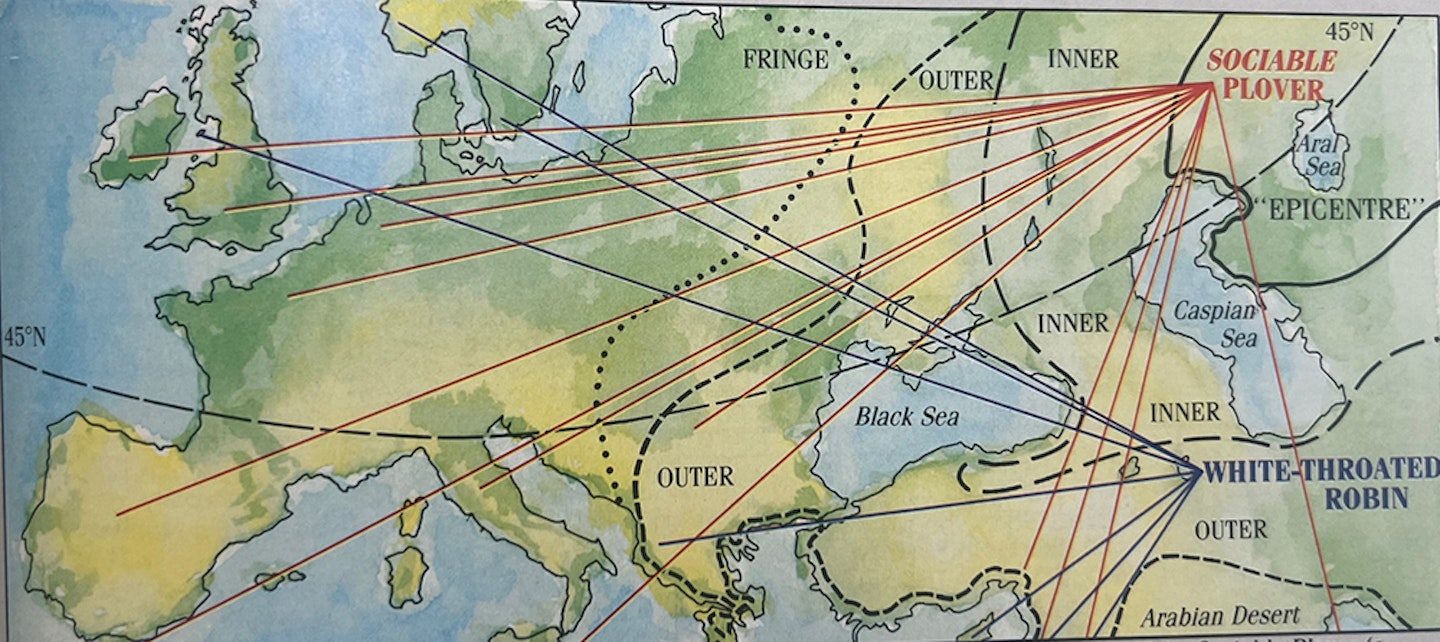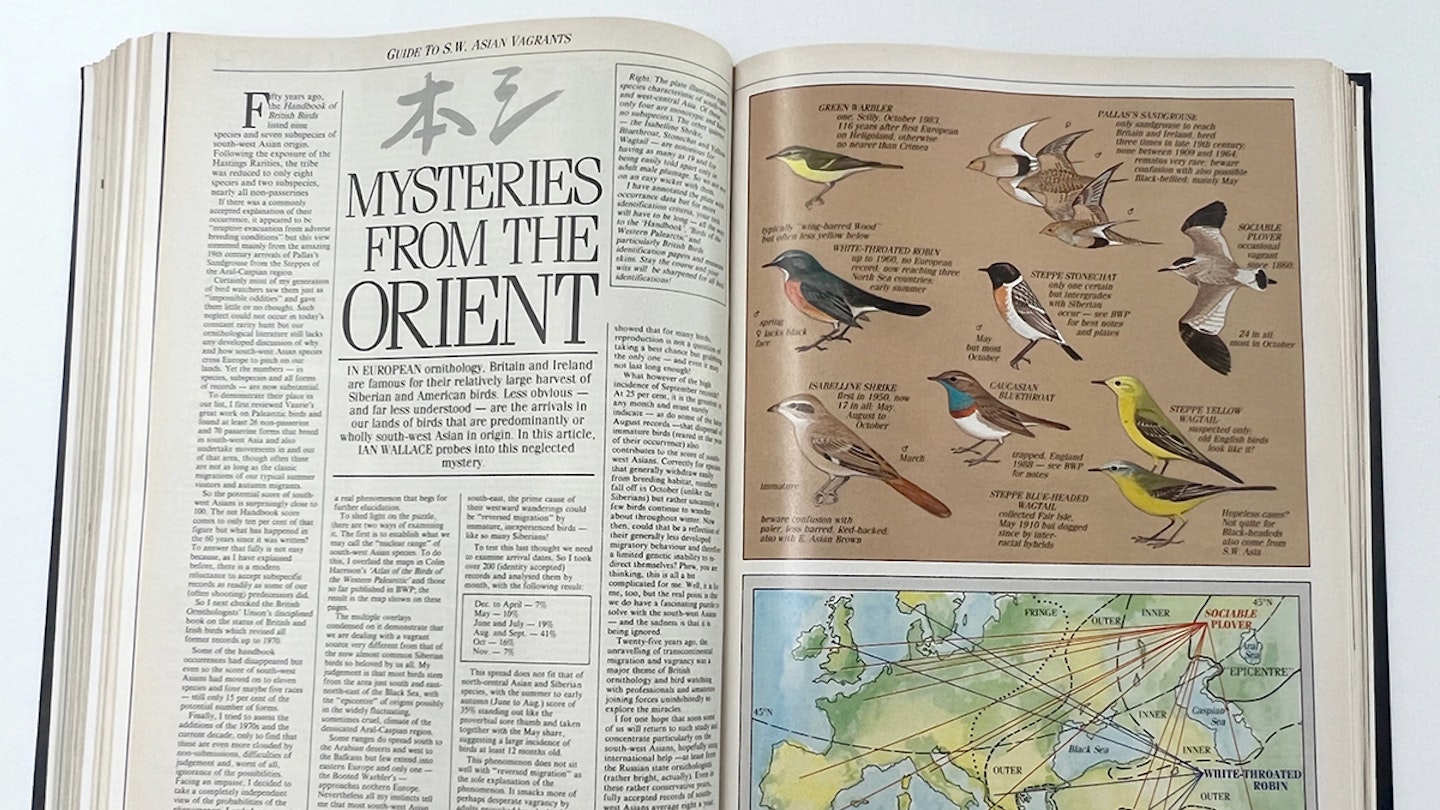Mysteries from the Orient
August 1988
In European ornithology, Britain and Ireland are famous for their relatively large harvest of Siberian and American birds. Less obvious – and far less understood – are the arrivals in our lands of birds that are predominantly or wholly south-west Asian in origin. In this article, Ian Wallace probes into this neglected mystery.

Fifty years ago, the Handbook of British Birds listed nine species and seven subspecies of south-west Asian origin. Following the exposure of the Hastings Rarities, the tribe was reduced to only eight species and two subspecies, nearly all non-passerines.
If there was a commonly accepted explanation of their occurrence, it appeared to be "eruptive evacuation from adverse breeding conditions" but this view stemmed mainly from the amazing 19th Century arrivals of Pallas's Sandgrouse from the steppes of the Aral-Caspian region.
Certainly most of my generation of birdwatchers saw them just as "impossible oddities" and gave them little or no thought. Such neglect could not occur in today's constant rarity hunt, but our ornithological literature still lacks any developed discussion of why and how south-west Asian species cross Europe to pitch on our lands. Yet the numbers – in species, subspecies and all forms of records – are now substantial.
To demonstrate their place in our list, I first reviewed Vaurie's great work on Palearctic birds and found at least 26 non-passerine and 70 passerine forms that breed in south-west Asia and also undertake movements in and out of that area, though often these are not as long as the classic migrations of our typical summer visitors and autumn migrants.
So, the potential score of south-west Asians is surprisingly close to 100. The net Handbook score comes to only 10% of that figure; but what has happened in the 60 years since it was written? To answer that fully is not easy because, as I have explained before, there is a modern reluctance to accept subspecific records as readily as some of our (often shooting) predecessors did.
So, I next checked the British Ornithologists' Union's disciplined book on the status of British and Irish birds which revised all former records up to 1970.
Some of the handbook occurrences had disappeared but even so the score of south-west Asians had moved on to eleven species and four maybe five races – still only 15% of the potential number of forms.
Finally, I tried to assess the additions of the 1970s and the current decade, only to find that these are even more clouded by non-submissions, difficulties of judgement and, worst of all, ignorance of the possibilities. Facing an impasse, I decided to take a completely independent view of the probabilities of the phenomenon. I ended up assessing the all-time arrivals in this puzzling group as up to 30 species and 18 races – nearly 50% of the target! Lunacy? I do not think so, because only a partial search of modern Scandinavian records showed a similar upsurge in south-west Asians. Thus, whatever its true scale, we do face a real phenomenon that begs for further elucidation.
To shed light on the puzzle, there are two ways of examining it. The first is to establish what we may call the "nuclear range" of south-west Asian species. To do this, I overlaid the maps in Colin Harrison's 'Atlas of the Birds of the Western Palearctic' and those so far published in BWP; the result is the map shown on these pages.
The multiple overlays condensed on it demonstrate that we are dealing with a vagrant source very different from that of the now almost common Siberian birds so beloved by us all. My judgement is that most birds stem from the area just south and east-north-east of the Black Sea, with the "epicentre" of origins possibly in the widely fluctuating, sometimes cruel, climate of the desiccated Aral-Caspian region.
Some ranges do spread south to the Arabian deserts and west to the Balkans but few extend into eastern Europe and only one the Booted Warbler's approaches northern Europe. Nevertheless all my instincts tell me that most south-west Asian vagrants come from their denser centres of populations and not their fringe communities. Their average journeys to Britain will therefore be 2,600 miles on a mean W by N heading and to Fenno-Scandia 2.200 miles on a mean WNW heading. Given that most of their normal winter withdrawals are to the south or south-east, the prime cause of their westward wanderings could be "reversed migration" by immature, inexperienced birds like so many Siberians!
To test this last thought we need to examine arrival dates. So I took over 200 (identity accepted) records and analysed them by month, with the following result:
Dec to April – 7%
May – 10%
June and July – 19%
Aug and Sept 41%
Oct – 16%
Nov – 7%
This spread does not fit that of north-central Asian and Siberian species, with the summer to early autumn (June to Aug) score of 35% standing out like the proverbial sore thumb and taken together with the May share, suggesting a large incidence of birds at least 12 months old.
This phenomenon does not sit well with "reversed migration" as the sole explanation of the phenomenon. It smacks more of perhaps desperate vagrancy by adults provoked by a lack of breeding opportunity in an ecologically unstable home range. So we are back with what was the primary factor in the ancient Sandgrouse eruptions. Those birds fled not drought but late spring snow.
Furthermore, my own experience in two out of four Middle East breeding seasons showed that for many birds, reproduction is not a question of the only one taking a best chance but grabbing not last long enough! And even it may not last long enough!
What, however, of the high incidence of September records? At 25%, it is the greatest in any month and must surely indicate – as do some of the later August records – that dispersal of immature birds (reared in the year of their occurrence) also contributes to the score of south-west Asians.
Correctly for species that generally withdraw easily from breeding habitat, numbers fall off in October (unlike the Siberians), but rather uncannily a few birds continue to wander about throughout winter. Now then, could that be a reflection of their generally less developed migratory behaviour and therefore a limited genetic inability to re-direct themselves? Phew, you are thinking, this is all a bit complicated for me. Well, it is for me, too, but the real point is that we do have a fascinating puzzle to solve with the south-west Asians and the sadness is that it is being ignored.
Twenty-five years ago, the unravelling of transcontinental migration and vagrancy was a major theme of British ornithology and birdwatching with professionals and amateurs joining forces uninhibitedly to explore the miracles.
I for one hope that soon some of us will return to such study and concentrate particularly on the south-west Asians, hopefully using international help - at least from the Russian state ornithologists (rather bright, actually). Even in these rather conservative years, fully accepted records of south-west Asians average eight a year. So the data base is still growing, while new forms continue to appear. Witness the superb White-throated Robin on the Calf of Man on June 22, 1983 and the crippling Caucasian/Iranian race of the Stonechat that graced Porthgwarra in early October 1985. The time is overdue for such surprises to be fully appreciated and not just twitched.

